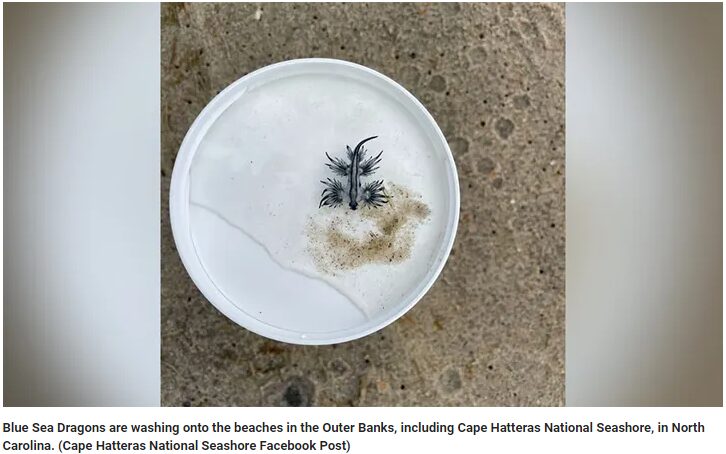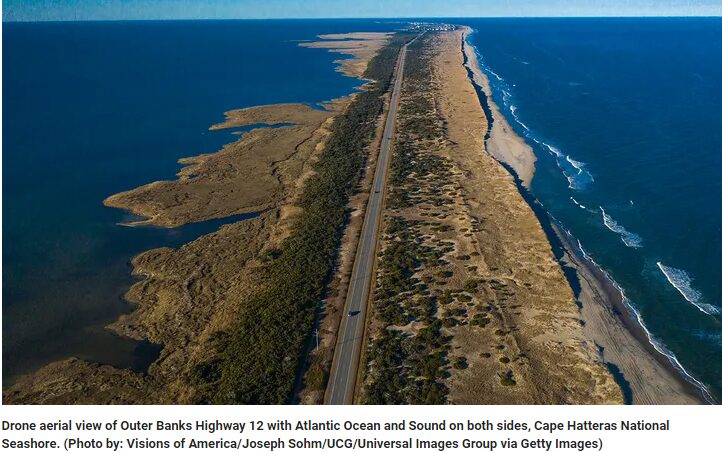Venomous creatures have been spotted washing up on the shores of North Carolina’s Outer Banks, prompting the National Park Service to issue a public warning about the dangers these tiny but powerful creatures pose.
The Cape Hatteras National Seashore recently shared on Facebook that Blue Sea Dragons, scientifically known as Glaucus atlanticus, have been found along the beaches. These creatures, despite their small size, are highly venomous and should be approached with caution.
“This venomous sea slug usually resides in the open ocean but can occasionally be carried ashore by strong winds,” officials explained in the Facebook post. “Although they typically grow to just about an inch long, don’t be deceived by their size—they pack a serious punch!”
Blue Sea Dragons, also referred to as sea swallows or blue angels, have an intriguing and striking appearance, with their vibrant blue and silver hues. According to Oceana.org, these creatures can grow to around 1.3 inches, and despite their delicate appearance, they carry venom that can cause harm to humans, as they feed on creatures like the Portuguese Man O’ War, absorbing their venom and using it for defense. This unique ability makes the Blue Sea Dragon a particularly dangerous presence on the shore. Visitors to the Outer Banks are advised to keep their distance and avoid handling these creatures.
12 Terrifying Ocean Creatures That Will Send Chills Down Your Spine

Blue Sea Dragons are commonly found in tropical and subtropical waters across the Atlantic, Pacific, and Indian Oceans. These fascinating creatures thrive in warmer regions, often carried by ocean currents to various parts of the world.
Classified as a type of sea slug, Glaucus atlanticus spends the majority of its life floating upside down on the surface of the ocean. This unique ability to remain buoyant is due to the creature’s capacity to trap and store air bubbles within its stomach, allowing it to effortlessly drift with the flow of the water. According to experts, this distinctive floating behavior helps the Blue Sea Dragon stay in its preferred environment, where it can hunt and avoid predators more effectively.
12-Year-Old from Montana Shocks Everyone with Record-Breaking Catch: ‘I Can’t Believe It!

Officials at Cape Hatteras National Seashore have explained that Blue Sea Dragons navigate the ocean by drifting with currents, all while feeding on their preferred prey—the highly venomous Portuguese man o’ war. These creatures are not only expert predators but also uniquely equipped to handle their dangerous meals.
“Due to their diet of such a venomous organism, Blue Sea Dragons have developed the ability to store the venom from the Portuguese man o’ war for their own defense,” the park service shared. “By concentrating the ingested venom, they can deliver an even more potent sting than their prey. For such a small dragon, their bite certainly packs a fiery punch!” This remarkable adaptation makes the Blue Sea Dragon not only mesmerizing but also a force to be reckoned with despite its tiny size.
Ocean Claims Home on North Carolina’s Outer Banks as It Collapses into the Sea

Given the potent toxin that these small but dangerous slugs carry, park officials strongly recommend that anyone who encounters a Blue Sea Dragon take care to observe it from a safe distance and remain mindful of others that could be nearby.
“These striking blue creatures often travel together in groups known as ‘Blue Fleets,’” officials noted in a recent post. “Whether found dead or alive, they retain their venomous sting, making them a potential hazard even when motionless. We encourage everyone to marvel at these fascinating organisms, but please refrain from touching them for your own safety.









